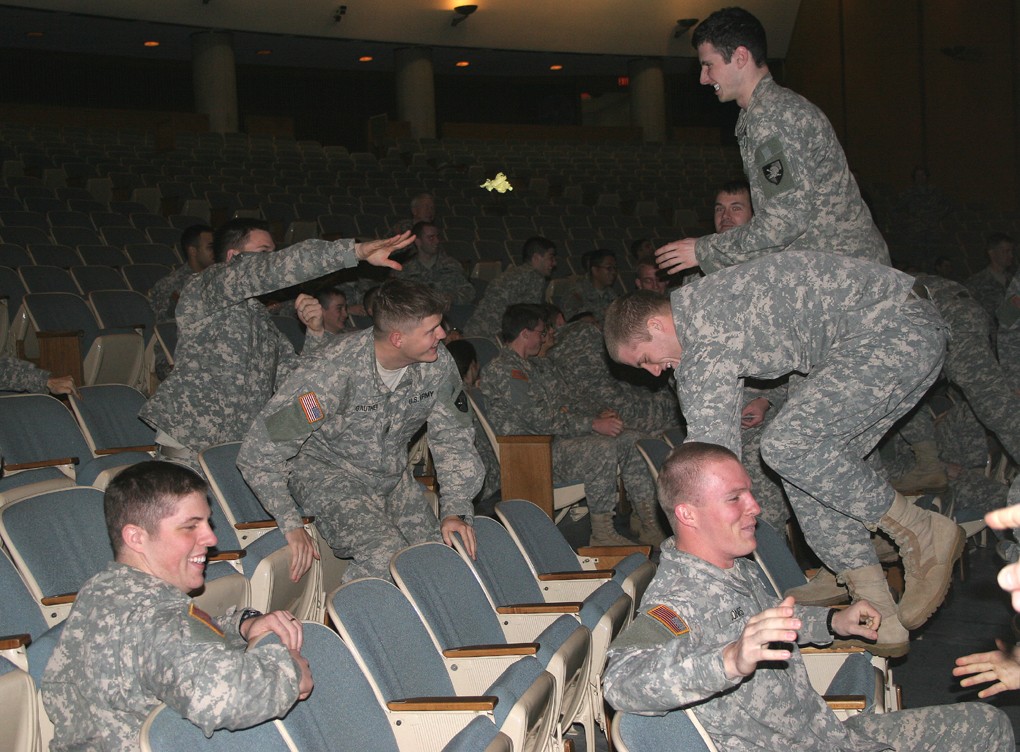Cadets taking History of the Military Art were given a glimpse of how trench warfare worked during World War I Jan. 28-29. Through a simple practical exercise, cadets learned how German and French tactics changed from 1914-18.
Major Thomas Spahr, instructor of military history and facilitator of the lesson, said the exercise was first designed by Cliff Rogers, the senior professor of military history, and has been refined and improved over the years.
The lesson took cadets out from behind their desks by dividing them into groups of German attackers and French defenders. The attackers were positioned on the stage in Robinson Auditorium while the defenders hid in the "trenches" between the rows of audience seats.
Cadets were given wads of paper to represent artillery and machine gun rounds. On the instructors' command, the attackers threw their "artillery" at the defending cadets. When they exhausted their artillery rounds, they were allowed to advance into the seats only by stepping on the arms of the chairs.
Their first battle, which simulated the tactics of 1914 and 1915, ended with the quick defeat of the Germans because of the French's close-knit frontline defense. In 1917, the Germans developed a "rolling barrage" of artillery in the hopes of taking the French frontline out of the picture. This was simulated in the lesson with a length of string strung between two instructors across the width of the defense area.
While the rolling barrage tactic was a slight improvement for the Germans, the outcome was the same as the last. The only change the French made at this time was an increase in their numbers on the frontline. But in the next year's battle, the Germans introduced the stormtrooper tactic to trench warfare. This time, a few of the cadets were allowed to walk into the aisles next to the seats in order to engage the French.
When this happened, the instructors paused the exercise, told the defenders to face the attackers, drop their paper and throw it again with the hand opposite what they normally used to simulate the loss of command and control. The stormtroopers easily crippled the French defense and marked a decisive German victory.
"I was surprised at the differences between each scenario's outcome," said Senior James Sessions III, from Company F-1 and a Wortham, Texas, native. "The number of people on each side did not change, but the shift in tactics/capabilities allowed for wildly different endings."
During and at the end of the class, the instructors and cadets discussed where the Germans' tactical ideas came from, Spahr said. Their lieutenants and captains, who witnessed firsthand the effects of battle tactics, developed their own ideas to pitch to senior leadership.
"The German army listened to ideas from the lower levels," Spahr said. "They were saying, 'this would work better,' and, 'why don't we do this''"
Spahr and the other instructors cited flexibility as the common factor between the German army of World War I and today's U.S. Army. When commanders asked for new tactics, they established an intent and gave their subordinates the freedom to interpret that intent and execute a solution.
Their discussion concluded the Germans were good at adapting to their enemy, understanding the conditions of warfare and developing tactical solutions.
But they did not have the strategy to manage their Soldiers and hold onto their victories. They also undermined the comparatively strong will of the French people, who were prepared to fight a longer war than the Germans expected.
Spahr hopes that the cadets will use what they learned to take their jobs as officers seriously and expand the knowledge base in their profession.
"We're teaching the cadets not what to think, but how to think about warfare," Spahr said. "Hopefully they remember (the exercise) because it's different from what they do in the classroom day in and day out."
The cadets enjoyed the lesson, both the physical aspect and the group discussion. It was another way the cadets were able to approach history lessons other than out of textbooks.
"It was a fun exercise, an escape from our normal classroom routine," said Senior Michelle Miller, from Company G-2 and a Gatlinburg, Tenn., native. "After class, it was easier to visualize how the battles happened better then looking at unit symbols on a map."
Spahr cites military personalities such as Gen. George S. Patton and Lt. Gen. Thomas "Stonewall" Jackson, as skilled tacticians and leaders who were also deeply interested in the history of warfare. He hopes that with lessons such as this, the military history department can not just teach history, but inspire passion for it as well.
"If you make learning fun, the cadets will learn more and learn better," Spahr said. "If we can get cadets to do that, then we succeeded."


Social Sharing